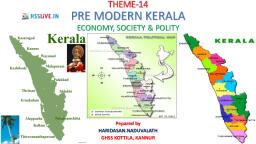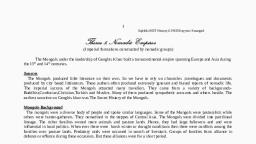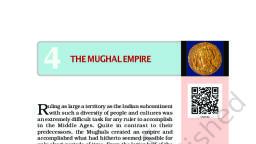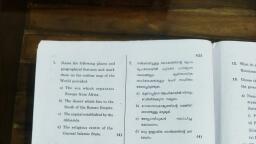Page 2 :
The Mongols under the leadership of, Genghis Khan built a transcontinental, empire spanning Europe and Asia, during the 13th and 14th centuries.
Page 3 :
NOMADIC EMPIRE
Page 4 :
The Mongols &, The Mongol Empire
Page 5 :
The Mongol Empire
Page 6 :
The Mongol Empire
Page 7 :
SOURCES, •, •, •, •, •, •, •, , Chronicles, Travelogues, Documents produced by city based litterateurs, Researches done by Russian scholars(18,19 C), Boris Yakovlevich Vladimirstov, Vasili Vladimirovich Berthold, Foreign Historians: Chinese, Mongolian, Persian,, Arabic, Latin, French, Russian languages
Page 8 :
Sources, • The Mongols produced little literature on their own., So we have to rely on chronicles ,travelogues and, documents produced by city based littérateurs., These authors often produced extremely ignorant, and biased reports of nomadic life., • The imperial success of the Mongols attracted many, travellers. They came from a variety of, backgrounds- Buddhist, Confucian, Christian,, Turkish and Muslim. Many of them produced, sympathetic accounts and others hostile. The, earliest narrative on Genghis khan was The Secret, History of the Mongols.
Page 9 :
Social and Political Background, • Pastoralists & Nomadic-hunters & food gatherers., • Grasses and shrubs can’t support agriculture, but, good for grazing., • Domesticated horses, goat, sheep, camels, cattles., • Formation of nomadic states was difficult because, of mobile lifestyle., • Live in portable yurts(Tents)- migrated from one, place to another with their herds., • Mingling of various tribes and people, • Tattar, Munch, Turkik tribes.
Page 10 :
Mongols, •, •, •, •, , Ethnic &language ties united them., Divided in to patrilineal lineages., Rich families possessed animals and pastures, There were conflicts over pasture lands They, formed alliances in defence or offence.
Page 11 :
Social and Political Background, • Population much smaller than, agricultural societies., • Women usually had a higher status., • Healthy adult men-compulsory military, service if needed., • Service under 4 sons of Khan and, selected captains (Noyan) of the military, units.
Page 13 :
Nomads often led caravans
Page 14 :
The Mongols, • Climate: Long winters and brief dry summers., • Genghis Khan conquered China, Iran and, Eastern Europe., • Throughout its history, China suffered, extensively from nomadic attack and Built, fortifications to protect their subjects., • Integrated into the Great Wall of China for, defending Mongolian attack. Built by ShiHuang ti.
Page 15 :
Great wall of China, Symbolizes the disturbance and Fear that brought, by the nomadic Raids on the agrarian societies of, North China and Central Asia
Page 16 :
Great Wall of China
Page 17 :
Great Wall of China
Page 18 :
Great Wall of China
Page 19 :
Great Wall of China
Page 20 :
Genghis khan (1162-1227)
Page 21 :
Genghis Khan- Early Career, ~ Roughly 3 million people, ~ Population density 1.36/ square kilometer, , Original Name-Temujin, , ~ More animals than people (ratio 12:1), , ~ 50% Rural: 50% Urban, Born in 1162 near Onon river, North Mongolia, ~ 90% of population ethnic Mongolian, , ~ Other 10% made up of Kazakh, Russian, Chinese and other
Page 23 :
The career of Genghis Khan, • Born in Northern Mongolia, near Onon river, in, 1162-Real name – Temujin., • Father - Yesugei, murdered by Tatars when he was, at the age of 12., • Mother Oelun-eke, raised Temujin., • Married to Borte at the age of 16, • Wife- Borte, was kidnapped and he had to fight to, recover her., • 4 Sons: Jochi, Chagatai, Ogodei and Tolui.
Page 24 :
Early alliances, Formed alliances with…., Boghurcha,a friend, , Jamuqa, his brother, and, Ong Khan, his old uncle
Page 25 :
Genghis Khan, • In 1206 Quriltai, an assembly of Mongol, chieftains, recognized Temujin and proclaimed, as the Great Khan of Mongols., • Khan organised the Mongol people in to a, more effective, disciplined military force that, facilitated his future campaigns., • Brutal attacks on china and Arab cities., • During his military campaigns about 137 lakh, people killed.
Page 26 :
Early Career, He defeated the Tatars, the Kereyits and, Naimans (tribes), , The assembly of Mongol chieftains, (Quariltai) recognized him., , He was given the title Genghis Khan’Oceanic Ruler’
Page 27 :
I. Beginnings, • Mongol people roamed eastern steppe (vast stretch of, dry grassland across Eurasia) in loosely organized clans, – Nomadic, pastoralist (herd domesticated animals), – Horseback riding an essential part of life, , • 1200 – Temujin, a young clan leader, sought to unite, Mongols under one leadership, – Fought and defeated rival clans, – 1206 – at Quriltai (meeting of all clan, chieftains), elected khagan, (supreme ruler), • accepted title “Chinggis (or Ghengis), Khan”, meaning “universal leader”
Page 28 :
Campaigns of Genghis Khan, , The first of his concern was to conquer China, At that time ,China was divided into 3 kingdoms, , The Chin in the North, , His-Hsia in the Northwest, , Sung in the South
Page 29 :
His Hsia were defeated in 1209, , The Great wall of China was breached in 1213, , Peking sacked in 1215
Page 31 :
Genghis Khan died in 1227, , Prior to his death,, his empire was divided among his, four sons…
Page 32 :
Courier system-Yam, • Khan introduced a courier, system, • Connected distant areas of his, empire, • Fresh mounts and despatch, riders were placed in outposts, • Nomads paid Qubcur tax for its, maintenance, • Its speed and reliability, surprised travelers
Page 33 :
Qubcur Tax, , Q, u, b, c, u, r, , T, a, x
Page 34 :
Conferring titles, Conferred title of ‘blood brothers’ to, military persons. Honoured humbler persons, as bondsman, a title that indicate their, Close relationship with Khan.
Page 35 :
Establishes Mongol authority, , After war, peace was established (Pax, Mongolica), , , Travel & Trade along the Silk Route increased, It continued to North of Mongolia& Karakorum
Page 36 :
Communication&Trade, • Communication and travel was essential to, maintain the authority., • Travelers were given an entry pass (paiza in, Persian; and gerge in Mongolian) for safe, conduct., • Traders paid by tax for the same purpose.
Page 37 :
Genghis Khan and India, , , India escaped from Genghis Khan’s visit., , he considered returning back from one of his, expeditions through North India and Assam., Heat, natural habitat, ill omens reported by, his soothsayer made him to change his mind.
Page 38 :
Expansion of an empire, By 1213 empire had, extended as far south as the, Great Wall of China, By 1215 empire had, reached, the area of what is now, Beijing, Empire also reached, Caspian, Sea to the west and the, Persian, Gulf to the south.
Page 40 :
Organization of Army, , Tried to remove the old tribal identity of, groups, , , Stopped the old decimal system, Divided the tribal grouping and, distributed their Members into new military, units., No one could move from his/her allotted, group. If they do so they were punished, severely
Page 41 :
Military Organisation, • Military units were to serve under his, four sons and captains called Noyan., • A band of followers who served, Genghis Khan loyally for many years, became important in the new, system.
Page 42 :
Causes for Military success, United over 80 Mongolian tribes., Mongol Empire during his reign was most, powerful nation on earth at that time., Era of his reign known as the “Golden, Era” in Mongolian History., Created military strategies more, successful than had ever been seen, before.
Page 43 :
Military success, 1) Akiner, Shirin. “Mongolia Today”. Kegan Paul International., London, England. 1991., 2) Bawden, C.R. “The Modern History of Mongolia”. Frederick, A. Praeger, Inc. New York, N.Y. 1968., , 3) Goldstein, Melvyn C. “The Changing World of Mongolia’s, Nomads”. University of California Press. Berkley, C.A. 1994., 4) Hedin, Sven. “Across the Gobi Desert”. Greenwood Press., New York, N.Y. 1968, 5) Lattimore, Owen. “Nationalism and Revolution in Mongolia”., J. Brill. Leiden. Netherlands. 1955.
Page 44 :
Military success, 1. Horse riding and hunting skills provided fast and, fierce attacking., 2. Carried out field manoeures in winter by using frozen, rivers as highway to enemies’ cities and camps., 3. Carried out their knowledge of moving light in terrain, as an effective strategy., 4. Learned the importance of seige engines and naphtha, bombardment quickly., , 5. Engineers built light portable equipments which used, against opponents.
Page 45 :
YASA, • Meaning-Law or decree or order, • Legal code of Genghis Khan., • Tried to join together the Mongols, around a body of shared beliefs., • It recognized their kinship to Genghis., • It imposed on the defeated subjects., • It retained their ethnic identity., • It was an empowering ideology.
Page 46 :
Yasa, • In 1206 Khan declared in the Quriltai, assembly, • Codes for administrative control, hunting, organisations, army, postal system., • Orders and Judgement., • Helped for the unification of Mongols, for, domination and conquer., • Symbol of Mongolian identity.
Page 47 :
Administrative organisation, Genghis assigned the responsibility of, governing the conquered territories to his, four sons (these comprised four ulus)., , 1.Eldest son ,Jochi received the, Russian steppes, 2.Second son,Chaghatai was given the, Transoxianian steppe and north of, Pamir mountains, 3.Third son,Ogodei succeeded Genghis, and established capital at Karakorum, 4.The youngest son, Touly, received, ancestral land of Mongolia.
Page 48 :
Administrative organisation, • Genghis envisaged that his, sons would rule the empire, collectively., • Military contingent (tama), were placed in each ulus., • All decisions relating to, family or state were, collectively taken at the, Assembly of chieftains, (Quariltai).
Page 49 :
Karakorum
Page 51 :
After Genghis, • 1260 – Qubilai Khan, grandson of, Genghis accepts title of “Great Khan”, – Succeeded in conquering all of China in 1279, , • Founded the Yuan Dynasty, lasted less, than 100 years, – Reunited all of China (including western and northern, regions), – Opened China up to more trade/foreign contact, – Tolerated Chinese culture, made few changes to, government, • But, kept Chinese out of higher offices, • Believed outsiders were more trustworthy, because no local, loyalties
Page 52 :
Qubilai Khan, • China ruled by Great Khan - Qubilai who starts, Yuan Dynasty., • Russia, Hungary, Poland - Golden Horde., • Promotes Buddhism but tolerates all, religions (favorite wife, Chabi, was a Christian)
Page 53 :
The Mongol attack
Page 54 :
The Mongol attack
Page 55 :
Situating Genghis Khan and the Mongols in, World History, , • Genghis Khan is remembered in the, history as a conqueror, destroyer of cities, and a person responsible for the death of, thousands of people. But for the, Mongols, Genghis Khan was the greatest, leader of all time. He united the Mongol, people, freed them from wars, brought, them prosperity and restored trade, routes and markets.
Page 56 :
Situating Genghis Khan and the Mongols in World, History, Mongols were a diverse body of people. Inspite of, their own faith in Buddhism, Christianity, Islam etc., the Mongol rulers never allowed their personal, beliefs to dictate the public policy. They recruited, administrators and armed contingents from various, conquered lands. All this was unusual for the time, when they were ruling. Mongols provided, ideological models for the Mughals of India. Timur,, another monarch who aspired to universal, dominion, hesitated to declare himself monarch, because of Genghis Khan.
Page 57 :
Situating Genghis Khan and the, Mongols in World History, • After decades of Soviet control, the, country of Mongolia is recreating its, identity as an independent nation., Genghis Khan has appeared as an iconic, figure for the Mongol people, mobilising, memories of a great past in the foraging, of national identity that can carry the, nation into future.
Page 58 :
Decline of Mongols, • The Plague - Eurasian Pandemic-was, the Primary reason for the, breakdown of the Mongol Empire in, 14th and 15th centuries
Page 59 :
Key Words, , Yasa: Genghis Khan's code of law., Tama: The military contingents of the individual, princes., Quriltai: The assembly of chieftains where all decisions, relating to the family or the state- campaigns,, distribution of plunder, pasture lands and succession were collectively taken., Anda: Blood brothers of Genghis Khan., Naukar: Special ranking as his bondsmen, a title that, marked their close relationship with their masters., Qanats: Underground canals., Yam: A courier system introduced by Genghis Khan., Qubcur Tax: A levy that few the nomads paid willingly, for the multiple benefits that it brought., Baj Tax: Entry pass to travelers for their security.
Page 60 :
Samarkand, , THANK YOU








































































